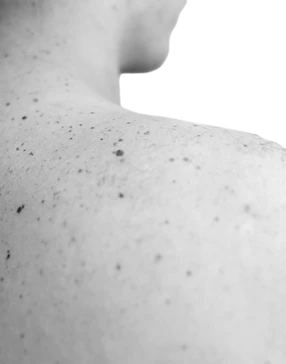Black skin cancer
Black skin cancer and its precursors
Dark accumulations of pigment in the form of moles can be found on everyone’s body. The majority of these birthmarks are benign and hardly change in the course of a person’s life. The so-called cellular congenital nevi can already be found after birth and new moles continue to appear over time. Their degeneration into malignant skin changes is extremely rare, but can occur, so that they are then referred to as skin cancer.
Diagnosis
To make the diagnosis, our dermatologists use a dermatoscope and a reflected light microscopy camera. This method magnifies the skin by a factor of 70, making it easier for us to make an accurate assessment. In the case of rapidly occurring changes, abnormal pigmentation and other factors such as bleeding or itching, the mole is completely removed and sent to the laboratory for histological examination.
GENESIS & CAUSES
One form of skin cancer is malignant melanoma. Malignant mel anoma occurs when the melanocytes of the skin are altered by a mutation. Possible causes of the mutation can be genetic predisposition, UV radiation (sunlight), spontaneous mutations, skin type and advanced age.
Dysplastic nevus cell nevi are precursors of black skin cancer. Our dermatologists use special test criteria to assess the extent of the change for further treatment.
Therapy
In the case of dysplastic nevus cell nevi, i.e. early stages of cell changes, a check-up with photo documentation should be carried out at regular intervals in order to detect possible changes at an early stage. It is also important that the patient is informed about the risk factors for skin cancer and how to deal with them. If a definitive diagnosis of malignant melanoma is made, the further procedure depends on the results of the histological analysis, which we will discuss with you in detail. Surgery is usually the method of choice, radiation or medication are rarely used.


